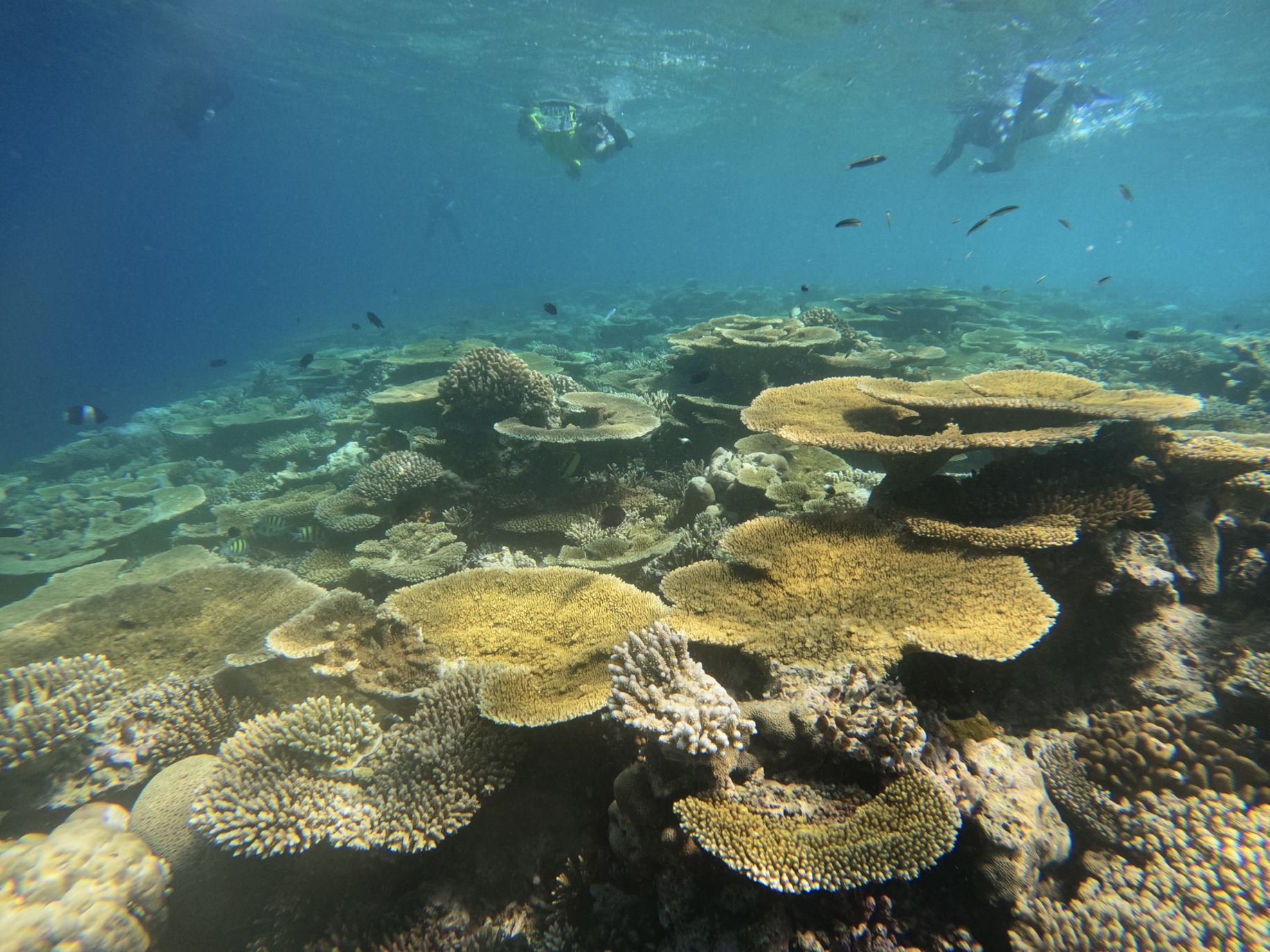The Maldives: Living life on the front line of climate change
Written by Wildlife & Welfare Researcher Charlotte Stadden
As part of our May edition of the Wildlife Calendar we have been focussing on endangered species in the Maldives. Our Researcher Charlotte Stadden visited the country in April and investigated the environmental issues they are faced with.
The reefs of Magoodhoo, Faafu Atoll, Maldives, April 2022
The Maldives is an island nation made up of over 1,200 small, low-lying islands and atolls, with roughly 200 of these being inhabited. It is thought that not only will the Maldives be one of the most significantly affected countries from climate change, but due to rising sea levels, the Maldives is likely to be the first nation to become fully submerged beneath the water. I was lucky enough to visit the Maldives in April (2022) to carry out field work as part of my master’s degree and as well as being lucky enough to see the beauty and diversity that its marine life has to offer, I also witnessed first hand some of the impacts that are already being seen in the country as a result of global warming, such as coral bleaching. However, this is only the tip of the iceberg when it comes to climate change effects in the Maldives. As part of our May 2022 Wildlife Calendar, Wildlife & Welfare have been focussing on conservation and biodiversity in the Maldives and in this blog, I will look deeper into the climate struggles being faced by this nation, living on the front line of climate change.
Rising sea levels are directly linked to the increase in atmospheric temperatures that have been seen since the industrial revolution, as this is the predominant cause of melting ice caps at our poles. With the highest land point in the Maldives lying no more than 3 metres above sea level and 80% of the land being less than 1 metre above sea level, the country is extremely vulnerable to any such fluctuations. Experts have predicted that if the world carries on with ‘business as usual’ almost 80% of the Maldives could be submerged beneath the waves by 2050. Not only would this be disastrous in terms of wildlife and biodiversity loss, but it would cause an unthinkable humanitarian crisis.
The Maldivian government holding an underwater cabinet meeting in 2009. Image: © CTV News
In 2009 the Maldivian government brought this disaster to the world stage by holding the first ever underwater cabinet meeting, to signify that within only a few decades the reality that could be faced by the nation. During this meeting ministers signed a document asking other countries to reduce their carbon emissions, which was to be presented at the Copenhagen Climate Change Conference later that year. As planned this demonstration brought the emergency of the situation to the public eyes, however, we are now 13 years on, and the threat is still as serious as ever.
If climate change and thus sea level rises can’t be halted or at least majorly impeded, then mitigation will have to be put into place for 550,000 inhabitants of the country, to prevent a devastating refugee crisis. Some of these mitigating tactics are already taking place such as relocation to islands less affected by rising seas. In 2008 it was announced by the then-president Mohamed Nasheed that the Maldivian government would divert a portion of the country’s annual tourist revenue into buying a new homeland to allow the population to relocate, should it become submerged. However, this idea did not appear to take hold and the focus shifted to other, more innovative ideas instead. One such innovation was the massive feat of geo-engineering that occurred to create the man-made island of Hulhumalé (dubbed the “City of Hope”) that began in 1997 and saw its first settlers in 2004. The island is connected via a bridge to the country’s capital, Malé, one of the most densely populated cities in the world with 130,000 people in just 1 square mile. With its main aim of allowing the people of Malé to relocate, Hulhumalé was created with sustainability in mind, with every aspect meticulously planned out, even down to the orientation of buildings, to optimise wind penetration and thus minimise the need to air-conditioning.
The Maldives floating city design inspired by brain coral.
A further, and possibly more exciting development is also taking place in the form of the Maldives Floating City project. The idea was coined at the 2009 Climate Conference in Copenhagen with the aim of the country working with the seas rather than against it, and after years of planning is now under development. It was thought that land reclamation, although at the time deemed necessary, would have a devastating effect on the environment and so alternative, sustainable options should be prioritised. This will be the world’s first floating city and has been designed with the environment at the forefront, being a carbon neutral, so-called “scarless” development of affordable housing for the local people.
Bleached coral in the Maldives after the 2016 mass bleaching event.
Image: © HANDOUT/Reuters
Unfortunately, the rising seas aren’t the only climate impact that the Maldives are battling. As previously mentioned, global warming is resulting in the Maldives, like many other countries in the tropics, facing an increasing frequency of mass coral bleaching. The staggering statistics show that in 1998 as much as 90% of the country's once abundant coral was lost in a bleaching event, followed by 60% loss in 2016. Coral bleaching causes massive knock-on effects on reef assemblage and biodiversity that the local people rely on for both income and sustenance. Additionally, the loss of coral also impacts the reefs’ ability to act as a barrier to wave action, resulting in an increase in frequency of both floods and tsunamis, causing devastation to local communities.
It is clear that even with these new technological advancements that have allowed developments such as the floating city to become a reality, the speed at which climate change is creeping up on us means that this will not be enough to curb the impacts that the Maldives and the wider world are facing. As one large community more must be done to halt or at the very least slow the rate of climate change if we are to prevent further loss to our biodiversity and any climate related humanitarian crises.
Please visit the Maldives Floating City to learn more about this exciting project.
To learn about the research being carried out on reef resilience in the Maldives you can visit The Maldives Resilient Reefs Project and Blue Marine Foundation
If you would like to learn more about endangered species in the Maldives, please visit our Wildlife Calendar:




